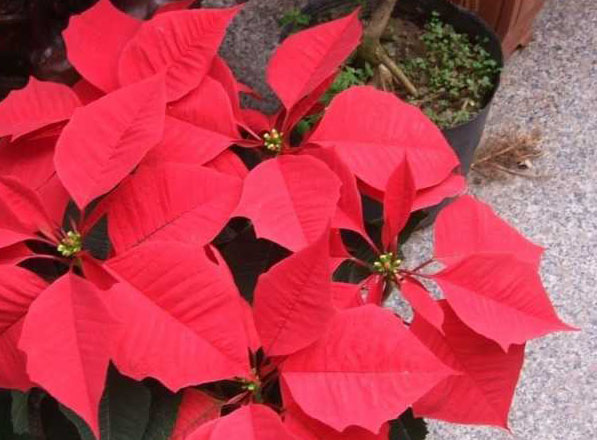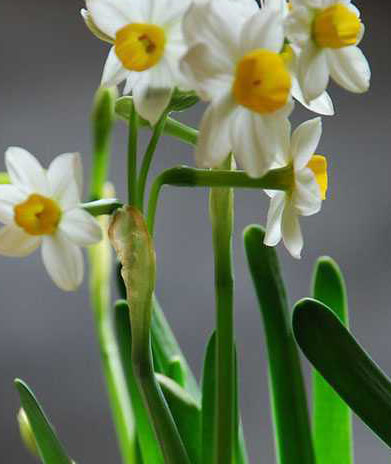How to cultivate potted poinsettia
Poinsettia is also known as poinsettia, ivory, etc. Is a semi-evergreen shrub. The stem has white milk. Inflorescences terminal, bracts near inflorescences scarlet. The florescence is during the Christmas season in mid-and late-December.
Potted poinsettia is suitable for changing pots every early spring. The pot soil can be mixed with 4 parts of rotten leaf soil, 3 parts of garden soil, 2 parts of sandy soil and 1 part of cake fertilizer. Pruning properly in combination with changing pots. Poinsettia is afraid of both drought and waterlogging, so it is necessary to pay attention to uniform watering to prevent it from being too dry or too wet, otherwise it is easy to cause the lower leaves of the plant to turn yellow and fall off. Each watering should be thoroughly watered until the surface of the basin soil is dry and then watered for a second time. New buds need less water when they just sprout, so they should not be watered down, otherwise they are easy to rot. The temperature in summer is high, and it is in the vigorous period of branch and leaf growth, so it is appropriate to irrigate once every morning, and in the evening, depending on the dry temperature of the basin soil, make up water once as appropriate, but the amount of water needs to be less. Water is usually watered every 1-2 days in spring and autumn.
In order to make poinsettia grow healthily, we should pay attention to timely and appropriate amount of fertilizer. During the growth period, if the nitrogen fertilizer is insufficient, there will be the phenomenon of falling leaves, so in addition to paying attention to the application of base fertilizer, it is the new bud and new branch growth period before and after the Beginning of Summer and Grain in Beard, so it is appropriate to apply thin pancake fertilizer and water every 2 to 3 weeks. After mid and late August until flowering, liquid fertilizer combined with nitrogen and phosphorus can be applied every 10 days or so to promote the growth of bracts and make the bracts more colorful. Nitrate nitrogen should be selected as nitrogen fertilizer, but ammonium nitrogen should not be applied.

Poinsettia like to have plenty of sunshine. Except for newly transplanted seedlings, they should be cultivated in a sunny and well-ventilated place all the year round. When the temperature is higher than 33 ℃, you should pay attention to proper shading to prevent the strong light from shining directly. Hot summer weather, cloudy and rainy after sunny should also pay attention to avoid exposure, but at this time need to frequently spray water to the leaves to prevent rolling leaves, yellow leaves or fallen leaves.
Poinsettia is not resistant to cold, and the leaves will turn yellow and fall off after frosting, so the northern region should enter the house in the first and middle of October and put it in the sunny place after entering. The room temperature should not be lower than 10 ℃, and the basin soil can survive the winter safely by keeping the basin soil dry properly.
In addition, the cultivation of poinsettia should avoid bruising and outflow of milk. If you bruise the stem and other places, it will flow out of white juice (toxic). If it flows out too much, it will affect its normal growth.
How to breed potted poinsettia in the family? Poinsettia (scientific name: Euphorbia pulcherrima Willd. Et Kl.): shrubs. Roots Terete, much branched. Stem erect, 1-3 tall, 1-4 cm in diameter, glabrous. Leaves alternate, ovate-elliptic, long-elliptic or lanceolate, green, margin entire or lobed or undulate-lobed, leaf surface pubescent or glabrous, leaf back pilose; bracts 5-7, narrowly elliptic, 3-7 cm long and 1-2 cm wide, usually entire, rarely margin shallowly undulate, scarlet. Inflorescences several Cymes arranged at the top of branches; involucral bracts altar-shaped, light green, margin dentate-5-lobed, lobes triangular, glabrous. Capsule, trigonous-orbicular, smooth glabrous. Seeds ovate, gray or grayish, subsmooth; caruncle absent. The flowering and fruiting period is from 10 to April of the following year.
The simplest and most feasible method of family potted poinsettia is cuttage culture. ① can be carried out from April to September, but the climate from May to June is the most suitable. The best cutting medium for ② is the mixture of perlite and grass ash at 1:1. ③ cuttage containers are made of plastic flowerpots with a diameter of 12cm to 15cm. ④ cuttings select 1-year-old branches, cut into segments of about 10 cm, cut off half of the leaves, and wash out the glue from the wound. ⑤ inserts the pre-prepared cuttings into the medium (the bottom of the basin is covered with a layer of ceramsite soaked with water, and then covered with a mixed medium full of eight points), the depth is half that of the cuttings, compacted with hands, watered, and finally tightly moisturized with plastic bags, placed in indoor scattered light or outdoor shade, and gradually see the light after a week. How to breed poinsettia in a family plant (photo)
The simplest and most feasible method of potted poinsettia in family is cutting propagation.
① can be carried out from April to September, but the climate from May to June is the most suitable.
The best cutting medium for ② is the mixture of perlite and grass ash at 1:1.
③ cuttage containers are made of plastic flowerpots with a diameter of 12cm to 15cm.
④ cuttings select 1-year-old branches, cut into segments of about 10 cm, cut off half of the leaves, and wash out the glue from the wound.
⑤ inserts the pre-prepared cuttings into the medium (the bottom of the basin is covered with a layer of ceramsite soaked with water, and then covered with a mixed medium full of eight points), the depth is half that of the cuttings, compacted with hands, watered, and finally tightly moisturized with plastic bags, placed in indoor scattered light or outdoor shade, and gradually see the light after a week.
- Prev

What kind of growing environment is required for daffodils?
Daffodils like warm, humid climate, avoid hot and high temperature; like wet water, more hardy. Narcissus is a bulbous flower planted in autumn, which has the habit of growing in autumn and winter, flowering and storing nutrients in early spring, and dormant in summer. Flower bud differentiation was carried out at the growing point of the bulb during the dormant period. 1. Light. Short sunshine flowers of the genus Narcissus
- Next

What kind of growth environment is suitable for Baobao flower?
The purse flower is called the lotus flower. The flower shape is peculiar, the Corolla has two lips, resembles two inflated sacs, the upper lip is small, stretches forward like a cover, and the lower lip is shaped like a bract bag. When the flower is in full bloom, the whole branch is covered with clusters of lotus-like flowers, so it is named lotus flower. There are many varieties and bright colors of purse flowers.
Related
- Fuxing push coffee new agricultural production and marketing class: lack of small-scale processing plants
- Jujube rice field leisure farm deep ploughing Yilan for five years to create a space for organic food and play
- Nongyu Farm-A trial of organic papaya for brave women with advanced technology
- Four points for attention in the prevention and control of diseases and insect pests of edible fungi
- How to add nutrient solution to Edible Fungi
- Is there any good way to control edible fungus mites?
- Open Inoculation Technology of Edible Fungi
- Is there any clever way to use fertilizer for edible fungus in winter?
- What agents are used to kill the pathogens of edible fungi in the mushroom shed?
- Rapid drying of Edible Fungi

